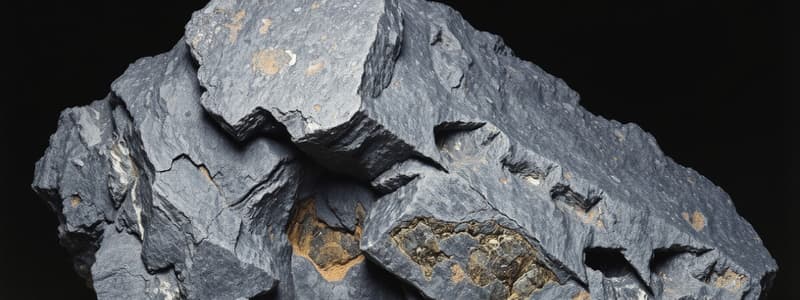Podcast
Questions and Answers
What is the chemical formula for Biotite?
What is the chemical formula for Biotite?
- K(Li,Al)3(Si,Al)4O10(F,OH)2
- K(Mg,Fe2+)3(Al,Fe3+)[(Al,Si)3O10](OH,F)2 (correct)
- K(Mg,Fe2+3)(Al,Fe3+)Si3O10(OH,F)2 (correct)
- KAl3Si3O10(OH)2
What is the hardness range of Biotite?
What is the hardness range of Biotite?
2.5 - 3
What is the primary rock type associated with Lepidolite?
What is the primary rock type associated with Lepidolite?
Igneous
Muscovite can appear in a variety of colors and forms.
Muscovite can appear in a variety of colors and forms.
What is the specific gravity range of Lepidolite?
What is the specific gravity range of Lepidolite?
The luster of Muscovite is ______.
The luster of Muscovite is ______.
Match the following minerals to their chemical formulas:
Match the following minerals to their chemical formulas:
Flashcards
Biotite Composition
Biotite Composition
Basic fluoro potassium, magnesium, iron aluminum silicate mica
Lepidolite Color
Lepidolite Color
Pink to purple lithium aluminum fluoro-silicate mica
Muscovite Color
Muscovite Color
Mica with variable colors due to chromium or manganese content.
Biotite Colors
Biotite Colors
Signup and view all the flashcards
Lepidolite Colors
Lepidolite Colors
Signup and view all the flashcards
Muscovite Colors
Muscovite Colors
Signup and view all the flashcards
Biotite Environment
Biotite Environment
Signup and view all the flashcards
Study Notes
Biotite
- Chemical formula: K(Mg,Fe2+3)(Al,Fe3+)Si3O10(OH,F)2; includes members of the Mica group.
- Members: Phlogopite, Siderophyllite, Eastonite, Annite, Fluorannite, Tetraferriannite.
- Composition: Basic fluoro potassium, magnesium, iron aluminum silicate.
- Colors vary: Black, dark brown, dark green, reddish black; lighter colors in members like Phlogopite and Eastonite.
- Streak: White; Hardness: 2.5 - 3.
- Crystal system: Monoclinic; forms include thick flakes, micaceous masses, and tabular shapes.
- Transparency ranges from translucent to opaque; specific gravity: 2.8 - 3.4.
- Luster: Pearly; Cleavage: 1,1; Fracture: uneven; Tenacity: sectile, elastic.
- Environmental context: Common in metamorphic rocks (schist, gneiss) and igneous rocks (granites, rhyolites); primary mica in rare earth pegmatites.
Lepidolite
- Chemical formula: K(Li,Al)3(Si,Al)4O10(F,OH)2; a lithium aluminum fluoro-silicate.
- Color typically ranges from pink to purple, with occasional light gray and yellow shades.
- Streak: White; Hardness: 2.5 - 3.
- Crystal system: Monoclinic; forms often as small, scaly crystals in dense aggregates.
- Transparency: Transparent to translucent; Specific gravity: 2.8 - 2.9.
- Luster: Pearly; Cleavage: 1,1; Fracture: uneven; Tenacity: sectile, elastic.
- Found primarily in high-lithium granite pegmatites, distinguishing its environmental preference.
Muscovite
- Chemical formula: KAl3Si3O10(OH)2; may contain chromium or manganese.
- Variable composition: K(Al,Cr,Mn)3Si3O10(OH)2; occurs in diverse colors, including colorless, white, beige, yellow, brown, gray, green, pink, purple, red, and black.
- Streak: Colorless; Hardness: 2 - 2.5.
- Crystal system: Monoclinic; forms thick flakes, micaceous masses, and unique aggregates (e.g., bladed crystals, star-shaped formations).
- Transparency: Transparent to translucent; Specific gravity: 2.7 - 3.0.
- Luster: Pearly; Cleavage: 1,1; Fracture: uneven; Tenacity: sectile, elastic.
- Essential in various geological settings, notably in granite pegmatites, contact metamorphic rocks, schists, and hydrothermal veins; significant deposits mainly come from granite pegmatites.
Studying That Suits You
Use AI to generate personalized quizzes and flashcards to suit your learning preferences.

